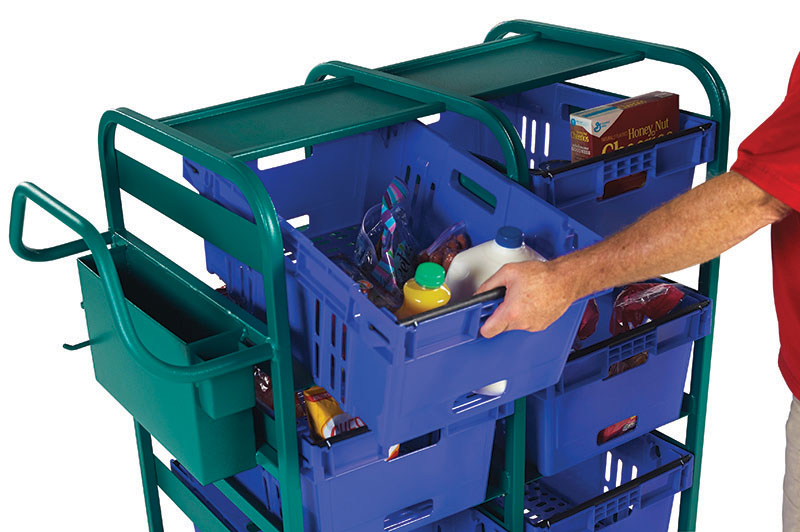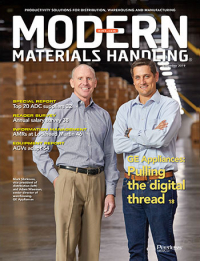Top 10 Trends in Totes, Bins and Containers for 2020
Here’s what shippers are asking for and how suppliers are delivering on those requests to make totes, bins and containers that can meet the rigors of today’s warehousing and DC environments.
As the receptacles used to move products or store them in the warehouse or DC, totes, bins and containers have been evolving right along with their users’ businesses. Driven by the uptick in e-commerce, the national labor shortage and the influx of automation in the warehouse, this evolution incorporates everything from private-labeled totes to wheeled bins to reusable containers.
“We’re getting a lot of different requests coming at us from many different directions right now,” says Ed Granger, director of sales at Quantum Storage Systems. Some want clear bins, others are looking for reusable containers, and still others want their storage systems to be color-coded to enable easier picking and packing. “Interest in these and other features picked up in 2019, and we expect that to continue into 2020,” he adds.
Trends to watch
With the warehouse as a whole undergoing some major redevelopment right now, it makes sense that the storage receptacles used within and outside of its four walls would be experiencing a metamorphosis of their own. Here are 10 trends the tote, bin and container manufacturers say are transforming the industry right now.
- Bins you can see through. Clear bins came of age in 2019 and will likely remain popular well into 2020. Granger says that Quantum first started making clear bins about 10 years ago, and they’ve since become the company’s fastest-growing product category. The concept is fairly simple: When the picker can visually see what’s inside the bin, it helps speed up the picking and packing process. “In an environment where every second counts,” says Granger, “simply having clear bins can help enhance productivity levels.”
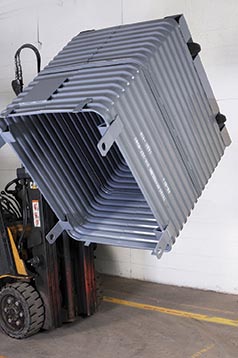
- Containers people can push around. The days when containers had to be moved by forklift through the warehouse or DC are long gone. With e-commerce pushing these facilities in new directions, the containers that navigate them have to be equally as flexible, adaptable and able to turn on a dime. At Steel King, container sales manager Craig Heil says more companies are asking for carts that have casters, handles and fork tubes. These add-ons come together to create a very portable cart whose movement doesn’t rely on a forklift. “People can push these containers around, push them up to a machine, use them to transport scrap and other tasks,” says Heil, who adds that Steel King introduced a round corner corrugated container with handles and casters this year. “These fill in for when you don’t have a forklift readily available to push things around, move containers into space spaces, or do a last-minute move,” he says.
- RFID’s moving from the trial phase to actual execution. The use of radio frequency identification (RFID) tags on containers and bins has been talked about for years, but 2020 could be the year when that vision begins to come into clearer focus. “One of the major trends has been this transition from RFID use in trials to actual execution,” says Andy Schumacher, vice president of packaging systems at SSI Schaefer. “It’s still very much in its infancy, but RFID is starting to take shape in the automotive industry, specifically.” Within that space, he says most of the major original equipment manufacturers are working with the same RFID developer to implement the technology in their supply chains. “We’re also seeing the development of some best practices around RFID usage,” Schumacher adds.
- Containers and bins are getting lighter. The push to make containers lighter, yet still as durable and accommodating as their predecessors, is on. “We continue to see a trend in weighting and trying to find ways to continue to keep the weight of the container down so more product can be put in the container,” says Schumacher. As those containers lighten up, they still must meet the specifications of the application. In other words, companies aren’t willing to sacrifice weight for quality (or features) when purchasing these items for their warehouses and DCs.
- E-commerce as the ultimate driver of innovation. Because it forces companies to pick down to the eaches level (where containers come into play), e-commerce continues to play a major role in the way totes and bins are designed, made and used. “E-commerce is having a large impact on totes,” says Andrea Nottestad, market manager for the retail supply chain at ORBIS. To accommodate these changes, she says more companies are seeking out new container solutions and then integrating them into existing operations. They’re also segmenting those choices across different aspects of e-commerce, including direct-to-retail, direct-to-consumer, and so forth. For example, where totes that are being delivered to retail stores typically have lids and handles, those that are used to fulfill e-commerce orders (pick-and-pack totes) may not even have lids or may have hopper fronts.
- Containers made from non-flammable materials. Heil says he’s been getting more inquiries from companies that want to replace their plastic containers with steel ones. “It goes back to the flammability issue of plastic,” he says. In some cases, for example, an insurance company may request (or even mandate) that a company move away from having plastic materials in its warehouse or DC. “It’s become more prevalent lately,” says Heil, who expects the trend to continue into 2020. “It’s really based on insurance companies becoming more proactive on the highly flammable [materials] and trying to reduce their risk.”
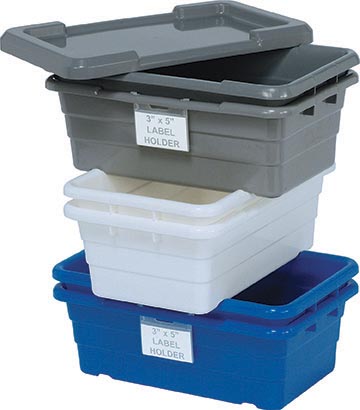
- Warehouse automation coming in at a close second on the list of drivers. Nottestad has also seen a shift in the materials that go into bins and totes and says that historically—at least in the United States—most were made from polyethylene. Today, the continued push to automate the warehouse is driving a shift in that material selection. In some cases, Nottestad is seeing more polypropylene, which is stronger, lighter and more durable by nature, used to accommodate different deflection requirements and tolerances of automated materials handling equipment. She expects this trend to continue. “As we see more automation coming in,” says Nottestad, “it’s impacting some of the materials that are being used in containers, totes and bins within the warehouse.”
- Private labeling that helps distributors retain their customers. Knowing how simple it is to Google a part number or company name and then figure out a product’s origin, more companies are using private label containers to keep the focus on themselves (versus the product manufacturer or another distributor). “We’re getting a lot of requests for private label right now,” says Granger. “Distributors are trying to protect their interests and hang on to their customers.” Accommodating these requests requires some work on the part of the supplier, which has to swap out its molds and name plates before making the bins. “We don’t do it for small batches of runs,” says Granger, “but we’re doing it for larger customers that don’t want to lose customers because someone tracked an order back to the manufacturer and went direct.”
- Returnable and reusable containers that allow companies to operate more sustainably. With more organizations focused on lessening their carbon footprints and implementing eco-conscious business practices, the supply chain is home to at least some of these initiatives. There, more companies are moving toward using more returnable and reusable containers and bins over, say, those made from cardboard. “We’re seeing more companies moving away from cardboard—where tops are torn off and the box is pitched into the garbage—and over to returnable bins that can be used again,” says Granger, highlighting a recent return on investment study that found it makes more financial sense to reuse cartons and bins, versus taking the age-old “disposable” approach.
“This is pushing a lot of the shift over to returnable, reusable containers and particularly for product delivery.” Schumacher adds that many companies want to understand the environmental impact of their container choices and then determine what they can do to continually reduce their carbon footprints. “That trend continues pretty strong,” says Schumacher.
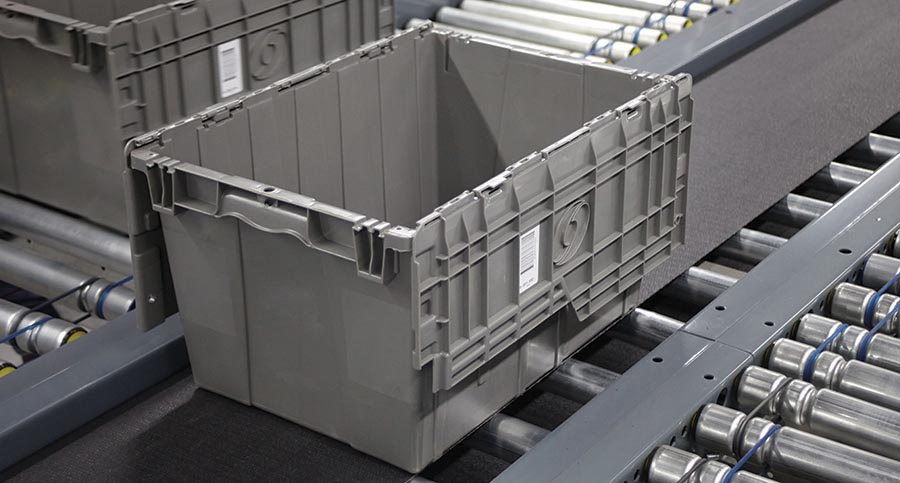 By taking a holistic approach to the entire warehousing setup, companies can do a better job of selecting the totes, bins and containers that make the most sense for their specific operations.
By taking a holistic approach to the entire warehousing setup, companies can do a better job of selecting the totes, bins and containers that make the most sense for their specific operations.
- The integration of bins, containers and totes onto a holistic warehousing approach. No longer just an afterthought that’s purchased once a new warehouse operator has all of the other puzzle pieces in place, totes and bins are coming into the conversation earlier in the process. By taking a holistic approach to the entire warehousing setup, Nottestad says companies can do a better job of selecting the totes, bins and containers that make the most sense for their specific operations. For example, a tote may have to interface with a pallet, or a container may have to work with other solutions in order to get a complete order staged for delivery. “If you don’t factor in the complete picture and ensure that all of the components work together,” says Nottestad, “you could wind up sub-optimizing in one area.”
Companies mentioned in this article:
ORBIS
Quantum Storage Systems
SSI Schaefer
Steel King

Article Topics
Containers & Totes News & Resources
K.Hartwall and its Australian distribution partner, Retailquip, join forces Flexcon unveils its innovative bin solutions Packaging Corner: Be open to change ORBIS expands manufacturing plant in Urbana, Ohio Tuggers, carts & casters work in harmony to fill the labor gap ORBIS hosts third annual golf outing to benefit Children’s Wisconsin Flexcon showcases variety of containers to support automation More Containers & TotesLatest in Materials Handling
Registration open for Pack Expo International 2024 Walmart chooses Swisslog AS/RS and software for third milk processing facility NetLogistik partners with Vuzix subsidiary Moviynt to offer mobility solutions for warehouses Materials Handling Robotics: The new world of heterogeneous robotic integration BSLBATT is looking for new distributors and resellers worldwide Lucas Watson appointed CSO for Körber’s Parcel Logistics business in North America Hyster recognizes Dealers of Distinction for 2023 More Materials HandlingAbout the Author
Subscribe to Materials Handling Magazine

Find out what the world's most innovative companies are doing to improve productivity in their plants and distribution centers.
Start your FREE subscription today.
April 2024 Modern Materials Handling

Latest Resources


